
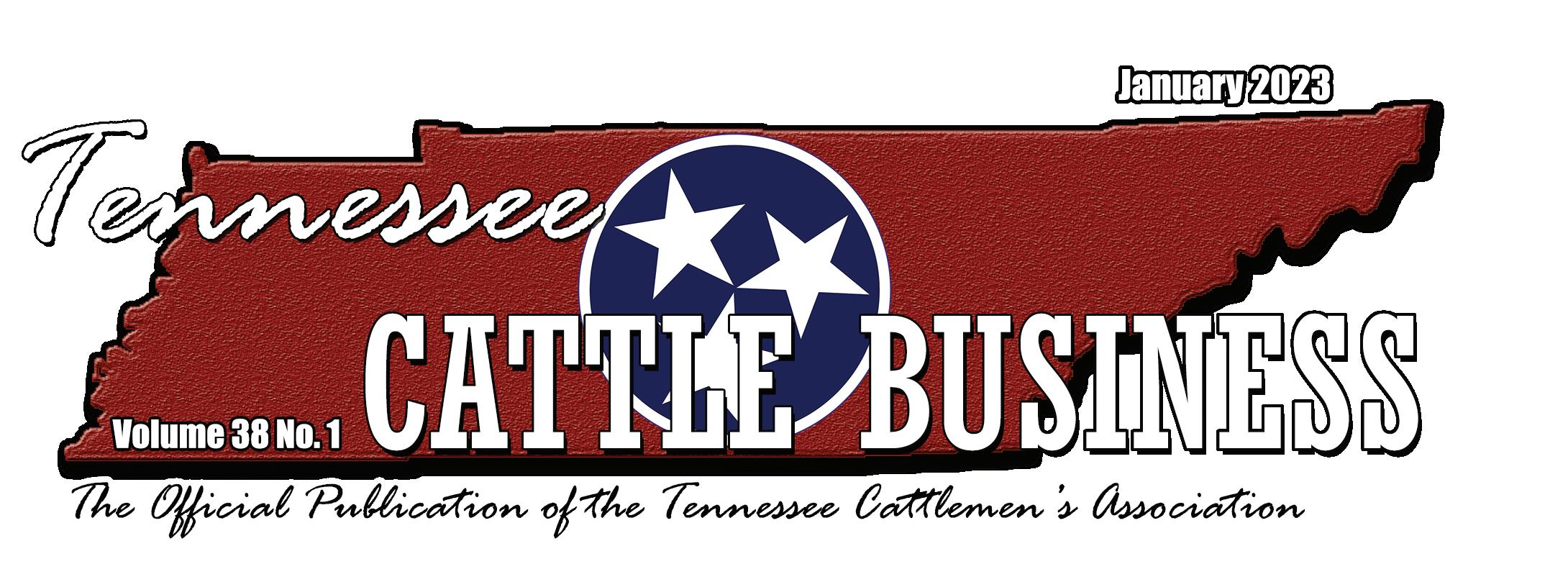
District Vice Presidents
Charles Rowlett • District 1
298 Bethany Church Rd. • Martin 38237 731-514-6348 (Weakley County)
Larry McCoy • District 2 1209 51 Hwy South • Ripley 38063 (731) 635-3823 (Lauderdale County)

Neal Watson • District 3
131 Deline Boonshill Rd • Petersburg 37144 (931) 703-3278
Eric Law• District 4
7864 Barnhill Rd • Primm Springs 38476 (615) 642-7506 • Eric.law@mtemc.com
Jim Bledsoe • District 5
1760 Poplar Cove Rd • Jamestown 38556 (931) 265-7201 (Fentress County)
Daryl Whittaker • District 6
3357 Rock Creek Rd • Estill Springs 37330 (931) 636-1037
Travis McConkey • District 7

3255 Crock Rd • Loudon, TN 37774 (865) 988-6151 tebefarm@gmail.com
Jeff Sellers • District 8
7609 Rogers Rd • Corryton 37221 (865) 382-5559 (Knox County)
Jerry Baker • District 9
3341 Cherokee Rd • Jonesborough 37659 (423) 747-7600
At Large Members
Nick Patterson • (931) 397-0847
2258 Henson Rd • Red Boiling Springs 37150
Luke Teeple • (931) 808-3786
3465 Duck Pond Rd • Sparta 38583
Gary Dering •901-355-9247
PO Box 115 • Rossville 38066
Dr. Hugh McCampbell • (423) 836-6016
407 Mayes Ave • Sweetwater 37874
Doug Dawkins • (865) 607-5880
4323 Cabbage Dr • Knoxville 37938
John Bradley • (901) 834-1034
425 Abrams Rd • Lutts 38471
Larry Church • (931) 698-5802
4077 Rippey Lake Rd • Mt Pleasant 38474
Summer Terry • (731) 608-4161
510 Cones Rd • Henderson 38340
Terry Snyder • Terry.snyder6@yahoo.com
6433 Hwy 67 W • Mountain City 37683
Director Emeritus

Wesley Parks • (901) 465-8837
17960 Hwy 76 • Somerville 38068
Frank Ingraham • (615) 794-1062
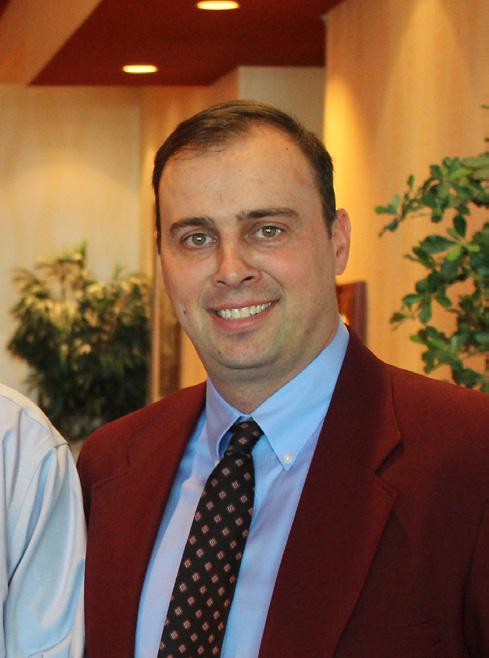
Tap Root Farm • Franklin 37064
Agribition/Seedstock Representative

Zach Butler • (615) 308-8628 butlercreek1952@aol.com
Tennessee CattleWomen’s Association
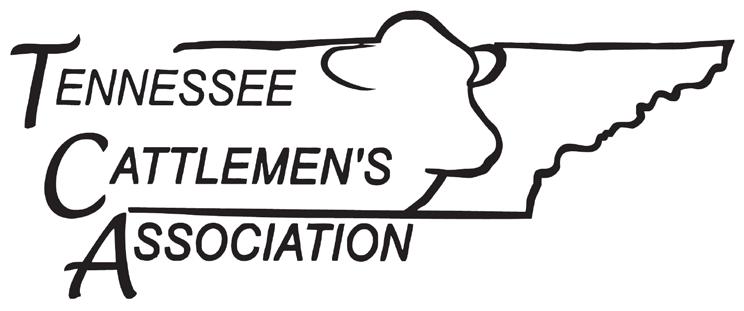
Madison Martin, president • (423) 519-9854



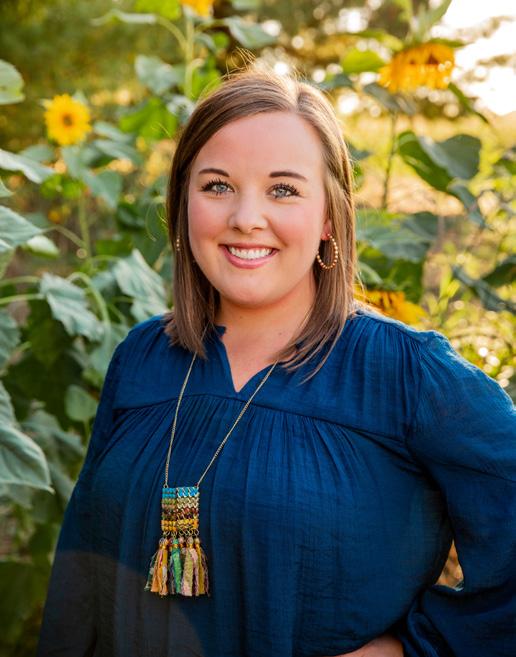
NCBA Representative
Linda Barnes • (731) 610-9210
1350 Ervin Hester Rd. Selmer 38375 Ex Officio Members Wendy Sneed - Tennessee Department of Agriculture, PO Box 40627 • Nashville 37204 Dr. Jim Neel • (865) 974-7294 Department of Animal Science, University of TN 2505 River Dr, Room 204 • Knoxville 37996 Dr. Justin Rhinehart • jrhinehart@utk.edu University of Tennessee • Extension Beef Cattle Specialist TCA 2 Staff and Leadership Charles Hord Executive Vice President Charles@tncattle.org Melinda Perkins Director of Youth Programs & Outreach Melinda@tncattle.org Lauren Neale Director of Communications Lauren@tncattle.org Roger Radel Past-President 930 Harrisburg Rd, Sevierville 865-453-4281 rhradel@hotmail.com Jay Yeargin President 3395 Hwy 54, Greenfield Yearginfarms@hotmail.com Dustin Pearson President-Elect 293 Spurgeon Gap Rd, Gray (423) 956-6178 Pearsoncattle@gmail.com Sally Wingler TCA Office Manager info@tncattle.org (615) 896-2333 www.tncattle.org Madison Martin President, TN CattleWomen 423-519-9854 tcwaexec@gmail.com
This month, we feature the Lick Skillet Farm of Jefferson County, which is a multi-generational business that prides itself on stewardship and quality beef production. They offer direct-to-consumer beef products to the surrounding community. Story by Charles Hord. Photos provided.
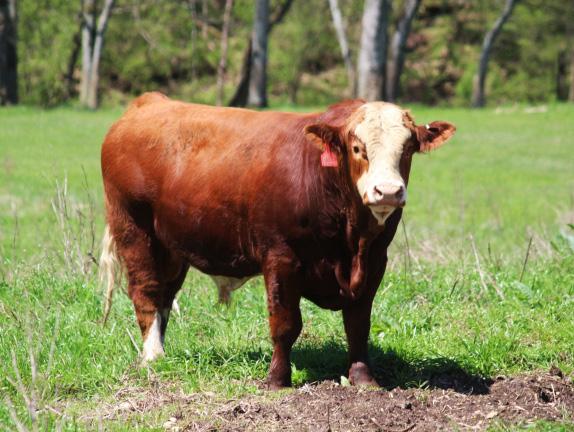


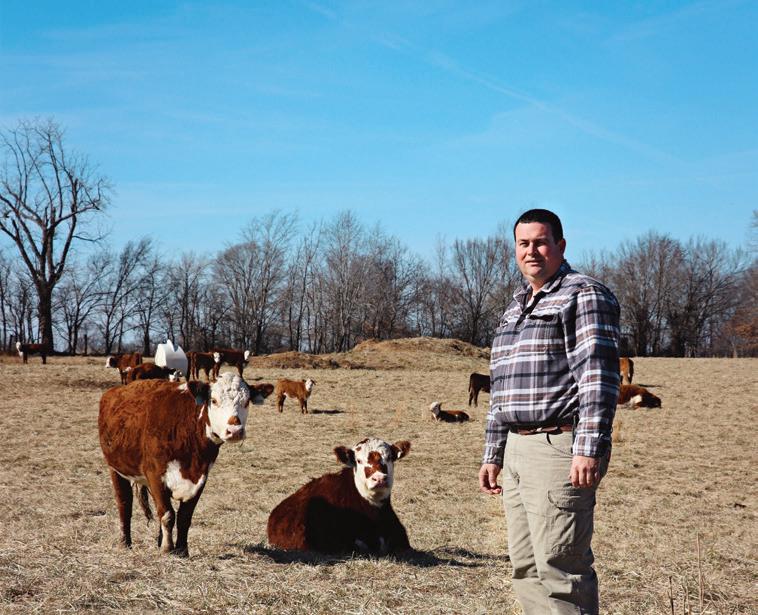

ON THE COVER:

Volume 38 No. 1 - JANUARY 2023
THIS
18
5 TCA’s
6 8
National Representative: Carey Brown, 859-278-0899 cbrown@livestockadvertisingnetwork.org IN
ISSUE
FEATURE 10
Agricultural Economics: Dr. Andrew P. Griffith, “New Year, New You, New Approach”
President’s Report
Jay Yeargin of Weakley County stands with his cattle at his family’s farm. Yeargin is the outgoing TCA president as of Jan. 2023. Photo by Melinda Perkins. The Tennessee Cattle Business magazine is published monthly by the Tennessee Cattlemen’s Association. For advertising rates and membership
information, visit www.tncattle.org or call 615-896-2333. TCA’s Executive Vice President’s Report TCA’s Youth Programs Report
3 Tennessee Cattlemen’s Association 530 Brandies Circle Suite B Murfreesboro, TN 37128 20
16
15
12
Q&A With Outgoing TCA President, Jay Yeargin
Veterinary Advice: Dr. Lew Stickland, ”Tips for A.I. Success”
Forage Specialist, Dr. Gary Bates, “When You’re Hot, You’re Not”
Beef Cattle Expert, Dr. Troy Rowan: “Bull Selection Made Easy”





February 4, 2023 • 12:00 Noon Garrison Livestock Arena - Cattle Complex 47th Annual Clemson Bull Sale presented by Clemson University & S.C. Cattlemen’s Association Also testing for: Average Daily Gain • Weight Per Day of Age • Breeding Soundness Exams Scrotal Size, Frame Score, Ribeye and Marbling Scans • Genomically Enanced EPD’s All Bulls Screened for Structural Soundness and Disposition Selling Angus • Balancer • Hereford Simmental • SimAngus For More Information Contact: Dr. Steven E. Meadows, Clemson Extension Beef Specialist • 864-633-9970 40+ Bulls & 30+ Open Heifers www.clemson.edu/extension/bulltest - WHERE PERFORMANCE AND FEED EFFICIENCY IS EVALUATEDIn-person and online live bidding via - MEASURING ECONOMICALLY RELEVANT TRAITS TO INCLUDE FEED EFFICIENCY WITH THE GROW SAFE SYSTEM -
BY JAY YEARGIN Tennessee Cattlemen’s Association’s President, Weakley County



As I write my final article as TCA president, I wonder where the time has gone. It has been a great two years serving in this role. I could have not done it without the support of my family and my farm crew that kept things going at home while I was gone to meetings. I am most thankful for the friends I have made across the state in the cattle industry, from fellow cattle producers all the way to legislators and friends in state government.

The job of being a “cattleman” isn’t for everyone. Some days are hard…and I’ve had one of those today. Some days are great…like watching the miracle of birth and a newborn calf taking its first steps. Some days, it’s the weather that’s magical, like the quiet snow falling in the fields. Today, I started with a cow in trouble having a calf which changed the whole day’s plans. Most of my family missed church and everyone pitched in to do what was needed. You know you have a great family when things can change so quickly but no one minds.
This reminds me of my years as president. We changed so much at the drop of a hat, especially around the pandemic issues. We were introduced to Zoom meetings, and social distancing, many of the national meetings I would have
normally attended did not happen. But still, I enjoyed my years as president and made the most of the new normal. We made things work…it’s just what we farmers do. Our life didn’t stop and the things that we needed to do got done. That’s what I love about our Board of Directors and farmers in general…that “just get it done” mentality. I’ve rambled enough but I truly want to say that I have enjoyed meeting all of you that I could during my time as president. I feel like the future of our industry is in great hands with all of those “can do attitude” farmers running our industry. Hope to see you all in the years to come.
5 Anderson...............................................Philip Warfield Bedford...........................................................Tyler Ray Benton.................................................Scott McDaniel Bledsoe.................................................Tommy Nipper Blount............................................................Mark King Bradley.....................................................Darryl Sneed Cannon....................................................Davy Sneed Carter...............................................Greg Whitehead Cheatham..............................................David Shores Chester.............................................Thomas Winbush Claiborne....................................................Ricky West Clay.....................................................Craig Ogletree Cocke...............................................Amanda Walker Coffee- Grundy.............................Matthew McBride Cumberland...............................................Terry Lowe DeKalb.............................................................Bart Lay Dickson...................................................Stefan Logan Fayette..................................................Mark FlemingFentress........................................................Jeff Brown Franklin...........................................Cory Dziadkowiec Gibson........................................................Justin Pope Giles..........................................................Brett McNeill Grainger..................................................James Acuff Greene...................................................Ernie Kleinlein Hamblen........................................................Bill Burgin Hardin.........................................................Ron Daniel Hawkins...................................................Jerry Lawson Henderson...................................................Nick Todd Henry.....................................................Angela Wilson Hickman....................................................David Bates Houston......................................................Sam Fussell Jackson.......................................................Tim Heady Jefferson................................................Brian Morgan Johnson....................................................Terry Snyder Knox/Union............................................Richard Neal Lawrence-Wayne...............................Marty Gambel Lauderdale............................................Lee Johnston Lewis.........................................................Kenny Ellison Lincoln..................................................Rujena Dotson Loudon............................................JoEllen Campbell Macon.........................................................Ken Roark Madison..................................................David Horton Marion....................................................Neal Ashburn Marshall......................................................Bo Jackson Maury......................................................Randy Jones McMinn..................................................Jayson Vicars McNairy...................................................Scott Roland Meigs......................................................Greg Buckner Middle Tennessee.................................Samuel Davis Monroe.....................................................David Watts Montgomery............................................Tom Barnett Moore.................................................Gordon Milsaps Morgan...........................................................Len Ross Northwest TN...........................................Mikey Pierce Overton...............................................Caleb Johnson Pickett......................................................Steven Gray Putnam............................................Howard B. Bilbrey Rhea.....................................................James Housley Roane............................................................Bob Tilley Robertson.................................................Clint Grubbs Rutherford .................................................Collin Miller Sevier......................................................John Delozier Smith....................................................Jake McCaleb Sullivan............................................Samuel Schallock Sumner..................................................Johnny Martin Tipton...........................................................Kirk Daniel Trousdale.................................................Blake Holder Unicoi.......................................................Bo Shadden Warren......................................................David Smith Washington.....................................................BJ Lewis White-VanBuren..........................Kenneth Whiteaker Williamson.......................................................Eric Law Wilson......................................................Clint Shipper 2023 COUNTY PRESIDENTS TCA PRESIDENT’S UPDATE
ASSOCIATION NEWS
EXECUTIVE VICE PRESIDENT’S UPDATE
BY CHARLES HORD Executive Vice President, Tennessee Cattlemen’s Association


Happy New Year from the Tennessee Cattlemen’s Association.
I need to start the New Year by recognizing a few individuals for their service on our Board of Directors. Jay Yeargin will remain on the Board as Past President but his two-year term as President of TCA ends. He has taken on a lot of responsibility these last couple of years and I appreciate his service. Roger Radel, past President of TCA, is ending his term on our board after serving 10 years in various roles. Also completing multiple years of service on our board are Dr. Bryan Beason, Larry Church, Doug Dawkins and John Bradley. Each of these individuals served without receiving any financial compensation including gas for travelling to board meetings. Thanks to each of you for your service on this board representing cattlemen and women.
By the time you read this our TCA Winter Meeting will be over. Thanks to Sally, Melinda and Lauren in the office for their hard work making it happen. Thanks to everyone that attended and supported. Look for complete coverage in next months magazine.
I always like to look back on the previous year to see where we have been and where we are going.
- A mob attacked the US Capital on January 6 resulting in the deaths of a protestor as well as Capital Police officers. TCA travels to DC annually and we interact with the Capital Police as we make our way to our Senator’s and Representative’s offices. It was difficult watching them being violently attacked.
- Russia attacked Ukraine in February. Almost a year later, the conflict continues resulting in significant loss of human lives as well as impacting food, fuel and fertilizer prizes around the world. Europe is facing a cold winter with limited heating fuels and much of Africa faces food insecurity and starvation deaths due to disrupted supplies. Increased fighting in Syria and Sudan has been linked to food insecurity.
- Drought conditions worsened across the western US. Farmers abandoned fields of fruits, nuts and vegetables and sold cattle. Cattle in the US fell below 92 million head. When cattle prices got so high in 2013-2014 cattle numbers fell to 88 million. In 2019 cattle in the US were up to 95 million head. In 1997 US Cattle numbers were 102 million head.
- There is a lot of optimism for cattle prices going into 2023 but cost of production continues to increase. Overall inflation in the US averaged 8% for 2022. Fertilizer prices remain
high. Volatility remains heading into 2023 with unknowns regarding global markets (China and Covid) and the conflict in Ukraine.
- On the policy side, discussions surrounding carbon credits and how farmers could benefit from companies net zero emissions pledges occurred. Solar farms and overall farmland loss are a hot topic in Tennessee. Cattle markets and bills addressing how cattle are sold have been hotly debated. We all agree there is a problem with farmers diminishing share of the retail dollar.
- Livestock Disease outbreaks impacted every livestock sector in 2022. Avian Influenza impacted poultry production in Tennessee and the US. Across the globe pork (African Swine Flu) and cattle (Foot and Mouth disease outbreaks, the Asian Longhorn Tick and more) disease outbreaks have brought disease surveillance and control to the forefront. The National Cattlemen’s Beef Association is lobbying to get additional funding for Foot and Mouth Disease vaccines in the 2023 Farm Bill.
Thanks for being a member of the Tennessee Cattlemen’s Association and best wishes for 2023.
6
ASSOCIATION NEWS
EMPOWER TOMORROW’S Land Stewards FOR INCOMING + CURRENT COLLEGE STUDENTS bit.ly/grassmanship2023 APPLY NOW $5,000 & $1,000 Grassmanship Scholarships Westin Cobb, 2022 Grassmanship Scholarship Winner Grassmanship™ means working together to nurture the relationship between grazing quality today and sustainability tomorrow.



Learn More & Stay in Touch MLS Territory Managers: mlstubs.com info@mlstubs.com Midcontinent Livestock Supplements MLS Proven Performance ® MLS #15 Hi Energy Improve forage digestibility and increase intake this winter with MLS Tubs that are available 24/7. calving and breed back for your herd. ® MLS Tubs Are A Sure Bet Don’t Gamble With Cow Body Condition Gary West 731-335-3023
IT’S MORE THAN RAISING CATTLE
 BY MELINDA PERKINS TCA’s Director of Youth Programs & Outreach
BY MELINDA PERKINS TCA’s Director of Youth Programs & Outreach

One of my most favorite youth programs we offer is the TCA/ Farm Credit Mid-America Youth Beef Heifer Initiative scholarship. Through this program, six youth members are awarded a scholarship to purchase a beef heifer to either show or simply begin their own herd. It is an application-based award that consists of the applicant’s leadership experience and accomplishments and completing an essay or video. In mid-December, the selection committee carefully reviewed the applications and was challenged with the task of narrowing their decision to only six recipients.
Specifically, my favorite aspect of reviewing the applications is reading the applicant’s essays and watching the videos that are submitted. This year the essay/video topics were: What opportunities would this heifer create for you? (Grades 4th and 5th) Why do you want to be involved in the beef cattle industry? (Grades 6th through 8th) As a young producer striving to grow in the cattle industry, how would winning this heifer benefit you? The essays and videos are judged on originality from the participant.
Since the essays/videos are judged on originality, there is obviously no right or wrong answer, but as I was going through the applications this year, I realized that all the essay and video responses have a common theme… Youth want to be involved in the cattle industry because it allows them to be a part of something bigger than themselves. They know the challenges that come with raising cattle, but they also know the greater reward. They have mentors in the cattle industry that they call on for help and strive to be like. They understand what it takes to improve their herd. They enjoy the sense of responsibility and pride that comes with owning their own cattle herd. They see the importance of carrying on their family legacy.
Getting youth involved in the cattle industry is about way more than just raising cattle. It’s about equipping our youth with the tools it takes to succeed in life. It’s about giving

them a purpose. Likewise, the TCA/ Farm Credit Mid-America Youth Beef Heifer Initiative scholarship program is more than just a scholarship. It is a tool for our youth to succeed. It is an avenue for our youth to express their originality and creativity. But, most of all, it is allowing our youth members to find their passion and place in the cattle industry.
The Youth Beef Heifer Initiative scholarship applications are available on September 1st each year, and due by December 1st. The recipients are then selected in lateDecember. This year’s winners will be recognized during the TCA Youth Awards Banquet on January 21st. There will be more coverage of the youth award winners in the March issue of the Tennessee Cattle Business magazine.


YOUTH NEWS 8
WAGYU JAPANESE GENETICS HAZEL GREEN, ALABAMA FRANKEWING, TENNESSEE Tommy & Clarice Ragland 256-714-6182 RaglandWagyu@gmail.com Polled and Black Wagyu Bred cows, Heifers, Bulls, and Embryos









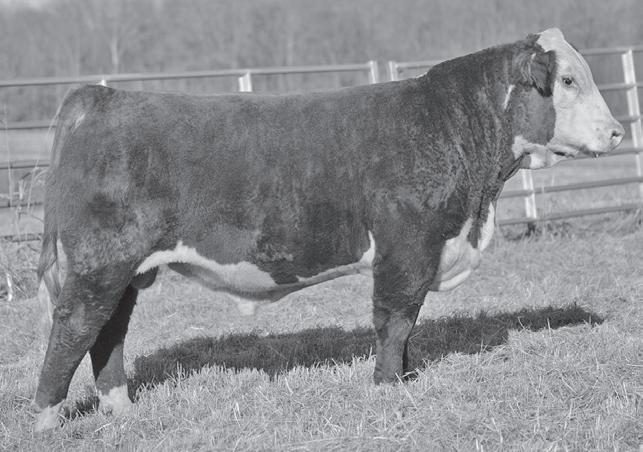


35 BLACK HEREFORD & HEREFORD BULLS Dustin
www.laytonauction.com 118 Powdermill Hill Lane Lawrenceburg, TN Jeremiah Malone 931.309.6805 Jeremy Smith, Herdsman 706.424.1744 27 Registered Spring Pairs & Heavy Breds – Black Hereford & Hereford 5 Commercial Angus Spring Pairs & Heavy Breds 7 Commercial Angus Fall Pairs HEREFORDS & BLACK HEREFORDS Noon (CST) at the Ranch Sale Headquarters Lawrenceburg, TN FEBRUARY 4, 2023 DOB: 9/6/21 73.75% Black Hereford Reg# HB022644 Homozygous Black & Homozygous Polled Sire: JO Jack Hammer 7A ET MGS: RR Hats Off P606 R85B CED: 9.7 BW: 1.3 WW: 53 YW: 66 Milk: 24 TM: 41 J086 ANNUAL BULL SALE DOB: 9/23/21 Reg# 44324419 Sire: BR Belle Air E126 ET MGS: TMG 8Y All Natural 4001 ET CED: 7.8 BW: 1.9 WW: 49 YW: 83 Milk: 27 REA: 0.45 IMF: 0.057 $CHB: 123 J118 DOB: 9/16/21 Reg# P44324439 Homo Polled Sire: BF Leveler 776 ET MGS: TMG 8Y All Natural 4001 ET CED: 1.0 BW: 3.0 WW: 60 YW: 84 Milk: 26 REA: 0.67 IMF: -0.023 $CHB: 97 J100
N. Layton 405.464.2455 Chisolm Kinder 405.747.4683
NEW YEAR, NEW YOU, NEW APPROACH
BY DR. ANDREW GRIFFITH Associate Professor of Agricultural Economics, University of Tennessee

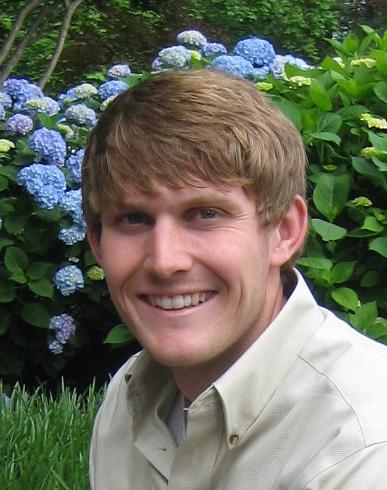
It is January 1st and a new year lays out like a blank canvas ready to be painted. The options of what to paint are limitless. The canvas could be transformed from a clean white sheet to any number of landscapes. It may have some “happy little clouds” or a “happy tree” (Bob Ross). Some people may choose to paint the entire canvas black and do some shadow painting. The idea of a blank canvas sounds inviting, because the idea of starting from scratch feels like a good option sometimes. However, starting with a blank canvas is rare in life and in business.
There are certainly aspects of life that can be completely reset and that holds for aspects of the cattle business, but it is rare for a completely clean slate. For instance, a person who has been in the cow-calf business for many years could sell all of the cows and start in a different sector of the cattle business. However, this is not a completely clean slate, because they may still be left with the same piece of land they have been farming for the same number of years that has poor quality grass, new fences that seem to be in the wrong place, water sources that are pristine, and the threelegged dog that saved them from getting trampled by the cow that was the reason for selling the whole cow herd.

Despite the desire to start with a clean slate and painting a completely unadulterated portrait, most cattle producers do hot have this option. Most cattle producers that are attempting to make changes on their operation would likely relate more to a tattoo artist covering up a mistake made during a time of impaired judgement than Bob Ross painting a mountain landscape. This is the same situation many cattle producers run into when marketing cattle.

The old adage of starting with the end in mind is key to marketing. No one can take a calf from a poorly bred cow and turn it into something it never had the potential to be. On the other hand, there are many people who have the ability to turn a calf with great potential into an eye sore. Given this perspective, there are sure to be producers evaluating several aspects of cattle production and marketing to change over the next year. Some of these issues can be changed sooner rather than later while other aspects will take a little longer.

Some changes to consider include reducing the reliance on hay and purchased feed to reduce overall feed costs, using technologies such as artificial insemination to improve the quality of the calf crop and to reduce the number of natural service sires in the herd, timing of marketing, product being marketed, or changing the sector of the business in which one participates. Most operations can not change these things overnight and
expect it all to be successful. However, producers can be making decisions today and planning for tomorrow in such a manner to improve the overall situation.
The reason for this discussion is because so many cattle producers are concerned with their ability to make money, and they have a fear that they will not make much money unless the price of cattle increases. With considerable certainty, cattle prices are going to increase in the next couple of years, but those years of higher prices will likely be followed by years of lower prices. The truth of the matter is that cattle producers do not control cattle prices, but those same producers do have the authority to make changes on their operations today that could and should improve their profitability. If there is nothing that can be done to improve profitability then that person may need to consider exiting the business if profitability is an objective.
The turn of the calendar to January has often been associated with making big changes, starting new things, quitting old things, and making resolutions that few people keep. The calendar should not be what dictates these changes, but rather the recognition that changes need to be made and starting that change now is better than waiting some indeterminant period. Now is the time to evaluate potential changes to the operation, because things are not going to get easier with time. The same can be said for personal changes. A person cannot harvest a forest if they never cut the first tree.
10
ECONOMICS
Hunt’s H+ Brangus Bull & Female Sale Sat., Feb. 25, 2023 1 p.m. • Calhoun, GA • Calhoun Stockyard Brangus and Ultrablack Bulls with “something extra” bred in! Productivity + Consistency + Integrity 55 Bulls 45 Bred/Exposed Reg. Heifers & Cows 40 Commercial Heifers Calhoun,Georgia 770.548.7950 www.huntsbrangus.com Selling:

BULL SELECTION MADE EASY
BY TROY ROWAN, Ph.D. Assistant Professor and Extension Specialist (Beef Genetics)
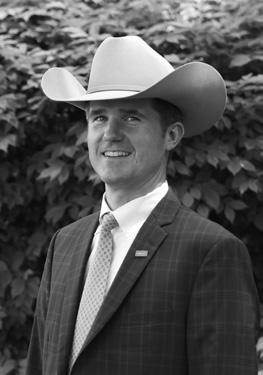

As we head into the new year, that means that bull-buying season is right around the corner. The bull purchase is one of the most consequential decisions that any commercial cow-calf operation regularly makes because it has such a huge impact on a herd’s profitability in both the immediate and long term. While the cows that you select as replacements have a single calf each year, a bull is going to have 25-40 times the impact on your calf crop annually! On top of that, the decisions that you make on a bull become multi-generational if you’re keeping replacement daughters. Making the “right” decision can pay dividends, and making the “wrong” decision can derail a herd for years.
This decision is even trickier when we’re selecting young, unproven bulls. Luckily there are a wealth of resources to mitigate risk and increase the likelihood that we choose the right bull for our breeding goals. These tools, EPDs and selection indexes, take some of the guesswork out of choosing sires. With this in mind, I wanted to walk through the process that I use when it comes to sire selection.
1) Make a plan
It’s essential to know what we’re looking for prior to selecting a bull. There is no “one-size-fits-all” bull. The right sire for an operation that is selling weaned calves and keeping replacement females will be very different than the right sire for one that sells freezer beef. Making a breeding plan includes evaluating which traits are important for maximizing a herd’s income (i.e., weaned calf pounds, red meat, etc.) and reducing its costs (i.e., heifer development, reproduction, feed, etc.). It is important to be conscious of our herd’s strong and weakpoints. This allows selection decisions to makeup ground where our cows are currently lacking while driving continued improvement in other important areas. Our breeding plan should also include identifying which breed of bull best allows us to take advantage of breed complimentarity and heterosis through crossbreeding.
2) Do some homework
We can do most all of our work in sire selection before we get to the sale. Armed with a sale catalog, we can get an idea of an animals’ genetic potentials, and do some “cutting” before even looking at bulls. Expected progeny differences (EPDs) are our best statistical estimates of an animal’s genetic merit. They are essential tools for sire selection because they remove sources environmental variation from a trait measurement and allow us to focus our decisions only on the component of a trait that an animal can pass to its offspring. Breed associations report EPDs for dozens of traits from growth to maternal ability to carcass merit.
When we are performing multi-trait selection the sheer number of EPDs can be hard to balance all at once, as some traits are more important than others and genetic correlations exist between traits that can work in opposition to one another with regards to overall profitability (think weaning weight and mature cow size). Economic selection indexes weight individual EPDs by their real-world economic value. These indexes report a single value that allows us to compare the expected profitability of sires’ offspring in generalized production scenarios. The resulting index is effectively an EPD for profit reported in dollars.
I always advise using the most relevant index to a herd’s breeding goal as an initial criteria to identify a top tier of sire candidates. For herds that sell weaned calves and retain replacement
females, maternal indexes (e.g., $M-Angus, $BMI-Hereford, APISimmental) are a great starting point to identify the top 20-30% of sires in a sale. It’s important to remember that bulls can arrive at the same index value in different ways, so following an initial sort on indexes with a closer look at individual EPDs can identify sires with high overall profit potential that also compliment your herd’s unique strengths and weaknesses. Using this information, we can head into sale day with our sights set on a handful of sires instead of the entirety of the sale offering.
3) Phenotypically evaluate
Using EPDs and indexes does not allow us to skip over a thorough phenotypic evaluation of a bull. Bulls need to be sound and fertile to deliver on the investment that we make on their genetic potential. Bulls that are unsound at 12-18 months are rarely ever going to improve over time, so evaluating foot and leg structure is a must. Further, ensuring that a bull has passed a breeding soundness exam is absolutely essential before you rely on him to start working. One oft overlooked trait in phenotypic evaluations is docility. A bull with all of the genetic potential in the world that tears up facilities and is a danger to you, your family, or employees is almost never worth the trouble. As such, I always encourage folks to include docility in their phenotypic evaluation on sale day.
4) Do a little math, then pull the trigger! Once you’ve sorted through the top tier of bulls at the sale using an index, then identified those that have favorable EPDs that match your herds needs, and done a sound phenotypic evaluation, it’s time to buy. Sometimes we find a bull that check all of our boxes, but they cost WAY more than what they could ever make up for in a lifetime. This is when price comes into play. Index values allow us to do some quick back-of-the napkin math (i.e., taking the index difference between two candidates times the number of calves you expect a bull to sire) to determine how much more one bull might be worth than another.
The bull buying decision is one of the most important things that a commercial operation does. Luckily we have tools that help make this decision a little easier. By using economic selection indexes and EPDs, we can do much of the “hard work” of bull selection before sale day, and ultimately identify sires that will positively impact our herd’s profitability in both the short and long terms.
Power of Angus.
12
CATTLE MANAGEMENT 12
A reliable business partner is difficult to come by. Contact Alex Tolbert to locate Angus genetics, select marketing options tailored to your needs, and to access American Angus Association® programs and services. Put the business breed to work for you.
Kentucky Ohio Tennessee © 2022-2023 American Angus Association 3201 Frederick Ave. | St. Joseph, MO 64506 816-383-5100 | www.ANGUS.org Contact Regional Manager Alex Tolbert: Cell: 706-338-8733 atolbert@angus.org
Alex Tolbert, Regional Manager

GOING WITH THE EBB AND FLOW
BY KATIE MASON, Ph.D. Extension Beef Cattle Specialist, University of Tennessee Institute of Agriculture
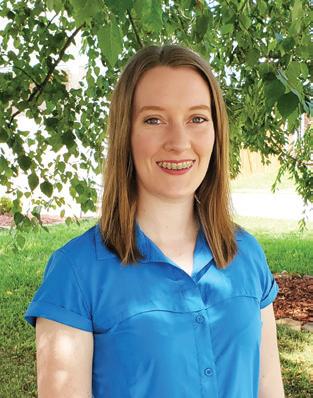
Just a few months ago, the common topic of discussion was drought status and its impact on pastures, hayfields, and cattle nutrition. During the winter, some areas receive heavy rainfall, sometimes creating flooding conditions and a lot of mud, especially in hay feeding areas. Moving forward into spring in the next few months, the grass will green up and it will be time to take advantage of the spring flush of forage growth. We understand that as the seasons change, management must change too, in response to weather conditions and the resulting forage availability. Not to mention, the cow herd’s nutritional needs are fluctuating throughout the year as well. The more we understand about seasonality as it relates to nutritional needs, the better we can do aligning those needs with the current conditions.
Since we’re in the midst of winter hay feeding season, here are a few tips related to mud management:
Short Term:
1. Identify well-drained areas to feed hay and supplement. Low-lying areas retain water and do not dry out as quickly.
2. Start at the back of a pasture/pen when feeding hay, and throughout the hay-feeding period, move the hay ring closer to the gate. This means less trips all the way across the pasture, reducing wheel traffic across the area.
3. Consider reduced-labor feeding options. Reduced-frequency feeding and bale grazing are ways to reduce daily feeding trips but must be done correctly to ensure that there is no ruminal upset or decreased animal performance.
Long-Term:
4. Consider creating a sacrifice paddock or heavy-use feeding area. Within this hay-feeding area, construct a concrete pad or use stone and geotextile fabric to reinforce the area that gets heavy traffic. While this method may not be able to be implemented in the thick of wet muddy conditions, it is something to consider for future winters.
5. Address equipment and facility challenges as appropriate, such as acquiring 4-wheel drive tractor(s) and hauling and spreading gravel into areas where needed.
While there is no perfect answer to managing muddy conditions, the considerations above can help to make the best of it until the next season.
As we look forward to spring, I want to take the opportunity to invite you to the Tennessee Grazing Conference on Friday, February 24th at
the James E. Ward Ag Center (East West Building) in Lebanon, TN. The program will run from 9 AM to 3 PM Central, with registration beginning at 8 AM. Since there has not been an in-person Tennessee Forage and Grassland Council meeting in a few years, I am so excited to bring folks together to talk about all things grazing. Topics include extending the grazing season, genetics for forage-based systems, research updates, temporary fencing, and more. The cost to attend is $40 per person. You may visit UTBEEF.com to register. The online registration form allows you to pay online or at the door. We will also take registrations on site the morning of the conference. If you have any questions, please feel free to reach out to me at kmason21@utk.edu, or 865-974-8941. I look forward to seeing you there!

14
CATTLE MANAGEMENT
WHEN YOU’RE HOT, YOU’RE NOT
BY DR. GARY BATES Director of the UT Beef and Forage Center


There was this old farm truck we had that didn’t have a very good radio. But we could pick up 101.5 WYNK. They played country music all the time. Some new songs, some old. There is no telling how many hours I spent with that radio blasting as I drove around doing various jobs. Classic country, new country, it didn’t matter – I sang them all. I came close to being a country music superstar and member of the Grand Old Opry. But I chose graduate school instead.
I loved listening to Jerry Reed. A lot of his songs had catchy lyrics, were sort of funny, and he could play a mean guitar. A favorite was “When you’re hot you’re hot.” The song was about how sometimes he was on a winning streak and sometimes he wasn’t. Either way he just kept going.
I think most all of us can relate to that song. Sometimes things are going good, and sometimes things don’t work out exactly like we planned. Either way, we have to keep pushing on to see if we can make the next day better. Since this is my first article of the new year, let me see if I can relate this back to your forage operation.
When you’re hot you’re hot – Bates. I’ve got a bunch of excess forage growing this spring, what do I do? Why not split part of the pasture off and graze a smaller area and cut some of the field for hay. That way you can get better utilization and get a decent hay cut, rather than having to clip pastures and let forage go to waste.
When you’re not you’re not – Bates, I’ve got a bunch of buttercup coming up in my pasture. How can I control it without killing my clover? If you apply no more than 2 pints
per acre of 2,4-D , you can kill buttercup without killing your established white clover. It will yellow the clover up some, but it will come back well.
When you’re hot you’re hot – Bates, I have some hay left over that I didn’t need to feed during winter. Can I save it until next year? Sure thing you can save it. As long as the bales are in the barn protected from the weather, hay is a very stable package that should last for several years.

When you’re not you’re not – Bates, I’ve got some fields that I didn’t get cut for hay so they are really mature. Would it be a good idea to make haylage out of it so the cattle will eat it? Well, you can make haylage out of it, but it won’t be very good quality. It will most likely be low in protein and energy, so you better run a forage test to see the nutrient content. Making haylage won’t improve the quality, it will only save what is already there.
When you are hot then celebrate the blessing and keep moving forward to the next one. If you are not, then push forward, clean up whatever mess you have, then move forward to the next good time. There are very few things that can’t be fixed in your forage program. It might take a little money and time, but you can do it.
Time for me to finish. I think Amos Moses is coming on next.
Important date to remember: Feb 24, 2023- Grazing conference, TN Forage and Grassland Council. Lebanon, TN Wilson Co Fairgrounds. 9 am CT. kmason21@utk.edu for more information, or see the adjoining page.
FORAGE
15
TIPS FOR A.I. SUCCESS
BY LEW STRICKLAND, DVM
Animal Science Department, University of Tennessee
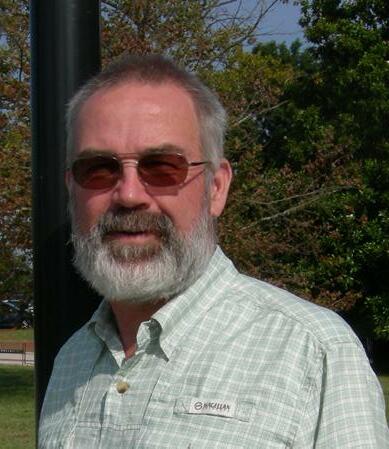
Spring breeding season will be here by the time you are reading this article. I realize that a large majority of TN producers are utilizing natural service (I’m writing this article while conducting BSE’s on the bulls at the UT bull test) however, some of you utilize artificial insemination (A.I.). There are several advantages to A.I. as in genetic improvement through access to semen without having to own the bull. Also, there is not the expense and maintenance of a bull in your pasture. While the technology of A.I. has advanced through the years, the basic principles are the same. Here are some ‘back to the basics’ tips for your A.I. program.
Proper Semen Handling
Depending on the sire, semen costs can add up quickly. Therefore, it’s crucial to make sure you handle the semen properly. Bull semen survives rather well with rapid plunging to -320°F, and quickly thawed to 95°F, however fluctuation in temperatures is detrimental. Using tweezers to handle the semen straw instead of your fingers will prevent thawing one portion of the straw ahead of the remainder. Additionally, if you are breeding multiple animals, it is recommended only handling the number of straws that you can successfully use within 15 minutes of thawing.

Once the straw is removed from the tank, shake it to eliminate any liquid nitrogen at the end of the cotton plug and then submerge in your thaw box. The semen should then be thawed at 95°F for 45 seconds. If this temperature is not accurate, the improper thawing could affect the quality and viability of the semen.
Loading the Cassou Gun
Once the semen has been thawed, it’s time to load the Cassou gun (make sure you’ve got the right bull!) Try to complete this process as quickly as possible, but not so fast that you are making mistakes. I personally prefer warming the gun by holding it my armpit for several minutes while I am preparing my equipment. Next, pull the plunger back about 6 inches, then wipe any excess water from the straw and place the straw inside with the cotton plug first. From there, cut the sealed end of the straw at a 90° angle, slide the plastic sheath tightly to seal and prevent back flow, then place the Cassou gun between your body and shirt to maintain the optimal temperature. I often will wrap the end of the gun with a paper towel to ensure extra insulation, and the towel is handy for cleaning the cow’s vulva.
Passing the Cassou Gun
It is typically recommended to use your left hand in the rectum and right hand to guide the insemination gun, but that may not work for everyone as your dominant hand may differ. Use a new breeding glove for every insemination and lubricate the glove with a commercial A.I. lubricant.
Forming a cone like shape with your fingers, gently enter the rectum and remove excess manure. Try your best not to remove your hand while cleaning out the rectum. This can easily introduce air and will make your job more difficult. Next, clean the vulva to prevent contamination and slowly insert the gun. I recommend inserting upwards at a 30° angle to prevent the gun from accidently entering the bladder. I often teach my students to think of it as “up and over.”
When the gun is 6 inches to 8 inches inside the vagina, raise the rear of the gun to level position and slide forward until it contacts the beginning of the cervix. If the gun is getting caught in the folds of the vagina, try stretching the cervix away from you with your left hand to free the gun and allow easier passage to the cervix. Once the cervix has been located, manipulate it over the gun to detect the cervical rings. Work the cervix over the gun, not the gun through the cervix, and never use force. The gun should slide freely with little resistance once the rings have been cleared.
Depositing
After the cervix is over the gun, it’s time to deposit the semen. Ideally, semen should be deposited just beyond the cervix into the uterine body. I feel for the tip of the gun once inside the internal ring of the cervix, and I know I’m in the right spot. Another analogy I use here is like shooting a rifle. Don’t pull the trigger as you might move your sights off the target. Squeeze the trigger, or in this case use your index and middle finger to grip the metal ring on the Cassou gun and slowly press the plunger with your thumb to deposit the semen. Once finished, gently remove the gun. Check for any abnormal discharge and note it in your breeding records. Some recommend horn breeding, which is going further up into the horn, but research has shown there is no difference in depositing the semen in the uterine body or horn breeding. This research also shows that even if horn breeding is used, the semen still reaches both horns.
Records and Clean Up
Last, but not least, it’s time to clean your equipment. Before taking off your breeding glove, remove the used sheath. Then dispose of your used glove and clean equipment thoroughly (no disinfectant, water only). Lastly, recheck to make sure the desired bull was used and note all information in your breeding records.
Our Extension program will restart the A.I. training program now that there is a new beef cattle reproductive specialist at MTREC. You can contact the center to inquire when the program will resume. If you have any questions, contact your Extension agent or me. 865-974-3538, lstrick5@utk.edu, or askdrlew.tennessee.edu.

CATTLE HEALTH 16
Does
Did you know?
• Every time a bovine animal is sold ‘private treaty’ (directly marketing beef products to consumers*, farmer to farmer, special sale, etc.,) $1.50-per head is due ($1.00 Beef Checkoff / $0.50 State Promotion)

How are Dollars being used?
• Advertising and promotion of beef


• Food safety, health and nutrition outreach
• Educating consumers about beef’s role in a healthy diet
• Refuting issues that could negatively impact the industry






Who pays?
• In most instances the seller pays the Checkoff, however both parties are responsible to ensure the remittance ($1.50 / head) is submitted. Failure to do so, is a violation of federal and state law and may be subject to late fees & penalties. This form is designed for the seller to use in all private treaty sales. * Direct Marketing transactions only are exempt from State $0.50



How do you pay?
• Complete a Private Treaty Sales Investment Form and send it with your check to the Tennessee Beef Council, 530 -A Brandies Circle, Murfreesboro, TN, 37128. For more forms call (615) 8965811 or visit TNBeef.org
17
Dollar
Your
@tnbeefcouncil @tnbeefcouncil @tnbeef @tnbeef www.tnbeef.org
Valerie Bass, TBIC Executive Director
The Tennessee Beef Checkoff + Beef Promotion Program
Tennessee Beef Checkoff & Beef Promotion Program Private Treaty Sales Investment Form Date: ___________________________________ Seller: __________________________________ Address: ________________________________ City, State, Zip: ___________________________ Seller’s Signature: _________________________ National Total # Sold: ____ x $1 per head = $_______ State Total # Sold: ____ x $0.50 per head = $_______ Total amount remitted $_________ Date of Sale: __________ State of Origin: ______ Buyer: __________________________________ Address: ________________________________ City, State, Zip: ___________________________ Buyer’s Signature: ________________________ Person remitting assessment: Tennessee Beef Industry Council 530-A Brandies Circle, Murfreesboro TN 37128
Generational Stewardship Remains Strong at Lick Skillet Farm

More than a century ago, George A. Miller, a struggling sharecropper, scraped up enough money to buy a small farm near the Holston River, northwest of New Market, in Jefferson County, Tennessee. The hillside farmland was badly eroded, with much of its life and resources gone. Neighbors warned that the land was "done wore out" and speculated he would "never make a go of it," and would end up having to "lick the skillet." But it was all he could afford, and through good stewardship, he managed to raise up cattle, tobacco, corn, cereal grains, hogs, chickens, and nine children on that land.
The farm remains in the family today with the third, fourth and fifth generations living and working on the farm. They are continuing their family’s stewardship practices and provide locally produced products to the community through Lick Skillet’s direct marketing farm operation.
Wyn Miller, great granddaughter of George A. Miller and the granddaughter of George and Betty Miller, works on Lick Skillet Farm full time. Her parents, brothers, nieces and nephews live on the farm and provide assistance in a variety of roles.
Lick Skillet operates a cow calf and grass-fed finishing operation, as well as pasture-raised hogs poultry, eggs and lamb for direct marketing. They sell through Farmers Markets, a website that includes a subscription service with pick up points and to local restaurants and grocery stores. Wyn believes locally provided food provides additional income for producers, processors, and others in the community while reducing costs associated with shipping beef out west. Wyn enjoys interacting with and educating consumers on what farmer’s do and finds the community feels a connection with the farmers they purchase from.
Wyn, a landscape architect by training with experience working with municipal water and soil quality engineering projects continues the focus on stewardship including incorporating silvopasture into the farm. Silvopasture (silva is forest in Latin) is the
practice of integrating trees, forage, and the grazing of domesticated animals in a mutually beneficial way.
Wyn Miller shared she has always loved planting trees and has since she was a little girl. She has found having trees strategically planted in a pasture not only provides necessary shade for the cattle and other livestock on the farm but can also help maintain the digestibility of the forages available although they may decrease overall biomass. Deep rooted trees do not compete for available water but can benefit stands particularly during dry conditions. She stresses a single tree in a pasture will just result in an area where livestock congregate but several can have a positive impact. Planting the correct species of trees also matters. Wyn has worked with the EQIP program through NRCS as well as a carbon credit market program through a tech platform called Working Trees. Working Trees promotes silvopasture and acts as a third-party conduit for producers to participate in the global carbon credit market. Working Trees also provides verification services for businesses buying carbon credits. Wyn said she sees carbon credits as a way to offset implementation costs, much like the EQIP program. “We knew we needed trees for shade, but working with Working Trees helped us recoup some of the costs of that up front investment into our farm, which would otherwise only have longterm benefits.” Wyn is hopeful that as the trees mature, the carbon payments will increase over the 30-year agreement with Working Trees.

18
Story by Charles Hord. Photos provided.
Wyn’s father, Dr. Alex Miller, has cooperated with the University of Tennessee Institute of Agriculture as well as NRCS to incorporate several environmentally sustainable practices through the years including incorporating native warm season grasses into pastures. These grasses provide diversification for species, summer grazing and because the roots are up to 10 ft deep, drought tolerance. These deep roots also have the potential to provide carbon sequestration in the soil. “As the emerging market for carbon sequestration develops, these grasses could provide opportunities for producers to monetize the carbon they are sequestering. Many companies in the US including JBS and Tyson Foods have developed long-term sustainability goals that includes being carbon neutral in the coming decades.” shared Dr. Forbes Walker, a professor at UT in the Department of Biosystems Engineering and Soil Science who has worked with Lick Skillet in the past. “It is kind of the wild west in emerging carbon markets right now, but I believe in 5 years there will be real opportunities for landowners to participate.” Walker has heard of some Carbon Market companies attempting to sign up groups of producers under their umbrella but warns there is a lot of paperwork involved and some of these companies appear to be taking the lion’s share of the profits. He believes in time there will be better opportunities for farmers to access the global market themselves and keep more of the profits. He believes cattle producers in Tennessee and the entire southeast have opportunities to benefit financially but it will take some changes in management. Dr. Forbes Walker see’s livestock as the key to sustainability rather than a liability. ““It is important to remember that while cattle may produce a lot of carbon dioxide and methane, they do this a several acres per animal. There is a lot of potential to change the way we graze cattle and manage pastures, to increase carbon sequestration and reduce methane emissions.”
The University of Tennessee Institute of Agriculture recently received a $30 million grant from USDA to help grassland farmers enter the emerging carbon economy while enhancing productivity and ecological benefits. “This grant from USDA is a great opportunity to contribute to improved management of our state’s and region’s grasslands, our pastures and hayfields,” says Patrick Keyser, director for the Center for Native Grasslands Management and professor in the UT Department of Forestry, Wildlife and Fisheries. “Just as importantly, it provides a path forward that can link our family farms throughout the Mid-South to emerging agricultural carbon markets. To me, that adds up to healthier grasslands and more profitable farms.”

At the Middle Tennessee Research and Education Center (MTREC) in Spring Hill, cutting edge efforts are taking place to study and reduce methane emissions in cattle. Dr. Troy Rowan with UT’s Department of Animal Science shared that several factors are being studied to reduce methane emissions from cattle including feed additives and genetics. There is an
enclosed trailer at MTREC that cattle will enter to get fed and then their methane emission are captured and measured. “Curbing methane emissions at the animal level will rely on a two-pronged approach of temporary interventions like feed additives, and more permanent solutions like genetic selection. Groups at UT are working on both of these fronts using C-Lock GreenFeed units to measure emissions on grazing cows. My group is interested in understanding how genetics plays a part in methane emissions, and how that phenotype impacts other production traits like feed efficiency. Other groups are also interested in understanding how the microbes in the rumen drive emissions and efficiency, while others are trying to understand the impacts of forage type and quality” shared Rowan.
I asked Wyn, as an environmentalist, how she balances her love of farming and providing local meat to your community, with some of the environmental concerns around cattle and methane production? Wyn shared that she believes methane is a concern for the environment but that the work being done by the University of Tennessee Institute of Agriculture on ways to reduce methane production in cattle has lots of potential. Wyn is interested in partnering with researchers in finding ways to include practices in her grass-fed operation. Visit https:// lickskillet.farm for more information on purchasing products and on their conservation practices.

19
Q&A with Outgoing TCA President, Jay Yeargin
Yeargin finished his term as president earlier this month at TCA’s Winter Meeting in Lebanon.
TCA: What did you enjoy most about your time as TCA president?
JY: Meeting new people at the meetings and national conferences. Also, learning more about the cattle industry across the nation and a more in depth look at the cattle industry in our state.

TCA: What are some of your accomplishments?
JY: Maintaining an organization through Covid. I feel like I was able to keep the committee system working well to streamline our Board meetings and keep them on track.
TCA: What are your hopes for the future of TCA?
JY: New and changing youth programs to stay with times and reach a broad audience. More interaction with members at future regional meetings. And for TCA to stay relevant when issues/policies arise.
TCA: What advice can you give to others looking to get involved or take leadership positions?
JY: Stay/get active in your local chapter. Attend all district and state wide events. Get to know others in the organization. Be prepared to work with others and listen to what others want and be able to understand their viewpoint.
TCA: What are some things you see happening in the cattle industry that could affect/are affecting Tennessee cattle producers? Do you have any advice on how to handle them?
JY: One of the major hurdles I see is supply chain related. Covid has taught us many things. One of which is that our supply chain (our inputs and selling our product) can break
down at any time. The other hurdles I see are diseases and traceability. We are raising one of the only products that does not have a good system to trace our products. This puts us behind in consumers’ eyes and also, if we are facing a disease outbreak, it will be hard to trace back to where it started and to quarantine the right animals.
TCA: What would you say to a young person looking to enter the industry?
JY: Hang on and buckle up. Every day in the cattle industry is a new adventure. You never know what problem you are going to be faced with. I am positive about the outlook for the industry, but the cattle business is something that you have to commit yourself to and be in it for the long haul.
TCA: Why should someone be a member of TCA?
JY: TCA is a great organization to be a part of from our youth supporting activities to our monitoring of things coming up in the legislature, and with our great regional education programs geared to teach the producer ways to be more profitable and raise better cattle.
TCA: Anything else you would like to add?
JY: I have really enjoyed my time as president of TCA… even though part of my term was dealing directly with Covid issues/changes. It really changed the landscape of how things were done, especially at a national level. I have also enjoyed meeting new people and making new friends. I am really glad that I get to remain on the board of directors as past president for two more years to see more of our work completed.
20
Q&A by Lauren Neale. Photo by Melinda Perkins.

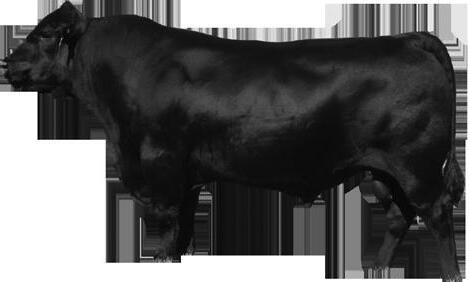








AMONETTFARMS.COM (931) 319-1411 • (931) 252-1907 • (931) 864-6481 BYRDSTOWN , TN One of the largest selections of private treaty Angus Bulls in the South! Numerous AI Sires Represented We Sell Bulls Easy Calving • Strong for Milk • Docile Growth & Performance • Foot & Leg Integrity All bulls qualify for Maximum TAEP Reimbursement WHITE HAWK RANCH 4765 Hwy 27 // Buchanan, GA 30113 Gary R. Hedrick (678) 858-0914 // g.hedrick@whitehawkinc.com Ben
Herdsman, Diego
Marketing,
Atkins
www.whitehawkbeefmakers.com WHR HERD SIRE PROSPECT OFFERED FRIDAY, FEB 17, 2023 SALE BOOKS BY REQUEST ONLY WHR 2023 SPRING BULL SALE EPD AVG. ID CED BW WW YW DMI SC SCF MILK M&G CEM MCW UDDR TEAT CW FAT REA MARB BMI BII CHB WHR Bull avg. 4.1 2.8 68 109 0.46 1.5 18.2 29 63 3.5 98 1.3 1.3 83 0.047 0.6 0.42 $412 $518 $162 AHA Avg. 2.6 2.8 53 85 0.2 1 15.5 25 52 1.7 87 1.24 1.25 67 0.015 0.39 0.1 337 406 113 40 HEREFORD BULLS Coming 2-Year-Olds WHR 839F 490E BEEFMAKER 822J P44293150 Tattoo: 822J BD: 08/16/21 Dam 490E WHR 845C 300G BEEFMAKER 812J P44293168 Tattoo: 812J BD: 08/12/21 Dam 300G CED BW WW YW DMI SC SCF Milk M&G CEM +3.9 +1.9 +67 +105 +0.7 +1.4 +19.7 +32 +66 +4.1 MCW Uddr Teat CW REA MARB BMI$ BII$ CHB$ +101 +1.40 +1.40 +97 +0.90 +0.30 +$ 441 +$ 536 +$ 163 CED BW WW YW DMI SC SCF Milk M&G CEM -1.8 +4.8 +75 +128 +0.6 +1.8 +13.8 +26 +63 -0.4 MCW Uddr Teat CW REA MARB BMI$ BII$ CHB$ +154 +1.30 +1.20 +89 +0.76 +0.61 +$ 375 +$ 496 +$ 190 SAVE THE DATE! Beefmaker Female Sale May 29, 2023 OVER 120 FEMALES HOMOZYGOUS POLLED HOMOZYGOUS POLLED
Hedrick (404) 216-4274
Gutierrez (678) 629-1804
James
(404) 922-6508
NCBA Seeking Interns for Fall 2023 in Washington, D.C.
the National Cattlemen’s Beef Association (NCBA) opened the application for public policy internships for the fall 2023 semester. This internship program is conducted in conjunction with the Public Lands Council (PLC) and offers interns an opportunity to support the advocacy work of NCBA and PLC in Washington, D.C.
“This is a unique internship experience for students who are interested in learning how NCBA and PLC represent livestock producers in our nation’s capital,” said NCBA and PLC Associate Director of Operations Justyn Tedder, manager of the internship program. “Interns work directly alongside NCBA and PLC staff to advocate for producers, attend meetings on Capitol Hill, communicate updates to our members, and conduct research to further our policy priorities. Interns become a part of our team and many of our past interns have gone on to successful careers in the beef industry or government.”
Interns will have the opportunity to engage with NCBA and PLC staff on several fronts including policy, communications, and membership, and will work closely with the lobbying and regulatory teams to advance policies important to the beef and sheep industries. Duties may include participating in lobbying efforts, reviewing Federal Register notices, participating in meetings with government agencies, collaborating with congressional and agency staff, and performing other duties as assigned.
Successful applicants have a minimum GPA of 3.0, be available for the duration of the internship (September 2023 – December 2023) in Washington, D.C., and have excellent research, writing, and communication skills. Applications are available on NCBA’s website and are due by Friday, March 24, 2023. Questions about the internship program may be directed to Justyn Tedder.
March Through NCBA Trade Show in the Crescent City
New Orleans has a lot of nicknames, including The Big Easy, Crescent City, NOLA and Paris of the South, but no matter what you call it, the Birthplace of Jazz will host the NCBA Trade Show as part of the 2023 Cattle Industry Convention. More than eight acres of exhibitors, displays and educational experiences will welcome attendees, Feb. 1-3.
The NCBA Trade Show offers cattle producers opportunities to network, learn, shop, dine and connect with friends, both old and new. It is a solutions center featuring more than 350 exhibitors that can help producers with animal health products, equipment, irrigation technology, software, trailers and so much more. In addition to finding the right product or service to solve any problem, there are a variety of educational opportunities within the show.
New in 2023, Cattle Chats will feature 20-minute beef industry educational sessions, with special spotlight sessions focusing on sustainability. Attendees can also stop in the Learning Lounge to enjoy informal, face-toface talks in an intimate setting right on the trade show
floor. Industry leaders will tackle topics such as ranch succession, effective probiotics, deworming protocols, animal welfare and tax trends.
The popular Stockmanship & Stewardship Demonstration Arena returns with stockmanship experts Dr. Ron Gill and Curt Pate providing low-stress cattle handling demonstrations, Beef Quality Assurance educational sessions, industry updates and facility design sessions. Interactive discussions will show how producers can shape consumer perceptions of beef and how the principles presented have significant economic and “quality of life” benefits when applied in a cattle enterprise.
The Chutes and Scales Showdown offers a side-by-side comparison of equipment where producers can watch cattle run through chutes then get hands-on experience. This is an opportunity to get up close and personal with some of the top manufacturers in the industry, learn about new technology on both manual and hydraulic chutes and find the right piece of equipment to fit your ranch needs.
The trade show experience continues each afternoon with food and fun. Wednesday’s welcome reception will celebrate 125 years of NCBA, Thursday’s Sippin’ in the Big Easy reception will feature Louisiana-inspired whiskey and foods, and Friday’s Pups & Suds Yappy Hour will help attendees wind down with some furry friends.
Recognized by Trade Show Executive magazine as one of the top 100 trade shows in the United States, the NCBA Trade Show is the largest of its kind for the cattle industry. A variety of registration options are available including trade show only and single day tickets, which include show access, lunch, receptions and educational activities. For more information and to register and reserve housing, visit convention.ncba.org.
NCBA Pleased with Changes in Cattle Contract Library Final Rule
NCBA welcomed the release of a final rule from the U.S. Department of Agriculture (USDA) to stand up the Cattle Contract Library Pilot Program. This program was authorized following NCBA’s engagement with Congress on the Consolidated Appropriations Act of 2022.
“We are pleased that USDA listened to feedback from stakeholders like NCBA while crafting the final rule on the Cattle Contract Library Pilot Program. We are hopeful that this pilot program will strike an appropriate balance between offering cattle producers additional insight into the market while also protecting their proprietary business information,” said NCBA Senior Director of Government Affairs Tanner Beymer.
The rule requires packers that slaughtered an average of not less than five percent of the number of fed cattle slaughtered nationally during the immediately preceding five calendar years to submit contractual information for the purchase of cattle.
NCBA NEWS
22
UTIA Research Seeks to Improve Price Discovery and Market Transparency in Hay Markets
A team of researchers from the University of Tennessee Institute of Agriculture is launching a study to improve price discovery and market transparency in hay markets. These improvements will help create a more efficient market and provide valuable information that benefits buyers and sellers of hay.
While hay constitutes a major feed source for many livestock operations, market values for hay have rarely been studied. Existing research focuses on hay auctions; however, most hay produced in the U.S. is not marketed through auctions. Rather it is grown and fed on the same farm or is sold through private transactions, which means no publicly available transaction information is recorded.



This lack of hay market information helped prompt the latest UTIA study, where researchers will conduct experiments to determine what hay attributes are valued by buyers and the value placed on those attributes given a variety of factors. Understanding the valued attributes can help provide guidelines to creating additional transparency, allowing producers to make more informed purchasing and selling decisions.
“We expect this project will result in buyers and sellers using information such as bale weight and nutritive assessment to determine the value of hay rather than relying solely on visual attributes,” said lead researcher Andrew Griffith, an associate professor in the Department of Agricultural and Resource Economics. “Hay buyers will benefit by knowing the exact quantity and nutritive value of hay they are purchasing, which in turn should assist with managing livestock feed cost and nutrition. Sellers will also benefit by knowing the attributes hay buyers value, so they can package and market their hay appropriately.”
Tennessee livestock producers averaged 143 days of feeding hay in 2017, which emphasizes the importance of hay on regional cattle operations.
“While this research will influence operations of all sizes, it can have a pronounced influence on producers with small- and medium-sized operations who trade relatively small quantities of hay and are less familiar with market dynamics and pricing,” said Griffith.
The study will be conducted by Andrew Griffith, Karen DeLong, Chris Boyer, Charley Martinez and Jon Walton, all from the Department of Agricultural and Resource Economics. The researchers are partnering with the Tennessee Cattlemen’s Association and the Tennessee Department of Agriculture on this three-year grant study, funded by USDA’s Agricultural Marketing Service.

TENNESSEE NEWS 23
White/Van Buren Counties
The White/Van Buren Cattlemen’s Association held their annual meeting on Dec. 1 with 165 attendees. The highlight was a ribeye steak meal cooked over an open fire by Town Creek Chuckwagon, caterers from Sparta, TN. They used their 1890s Owensboro chuckwagon to cook over an open fire using Dutch ovens.



After the meal, UT Extension agents Chris Hicks and Katie Martin talked about their media series “Telling Your Ag Story” which is an impressive way to reach consumers.
Officer elections were followed with an annual fundraiser event that included many door prizes. Board members sold raffle tickets to association members to win those prizes. This year’s grand prize was a registered Gelbvieh bull donated by Dolittle Farms (Thurman Mason).

District 1
The
1
Maury County
The Maury Co. Cattlemen’s Association awarded the winners of its $500 scholarships. These are given out annually to high school seniors who are pursuing a degree in agriculture. First row: Canton Grace Prentice and Lily Pearl Demastus.
Back Row: Board of Directors: Jeff Barnes, Bob Jones, Kevin Krause, Stanley Scott, Jonathan Mays, Phillip Griffith, and Randy Jones.

24 COUNTY NEWS
Johnson County
Johnson Co. Cattlemen’s held its fall meeting in November where they elected new officers and president, Dustin Pearson, gave updates on local and state issues.
District
meeting was held in November in Union City, TN at Discovery Park of America. BovIQ, Multi-Min, and H&R Agripower were sponsors.

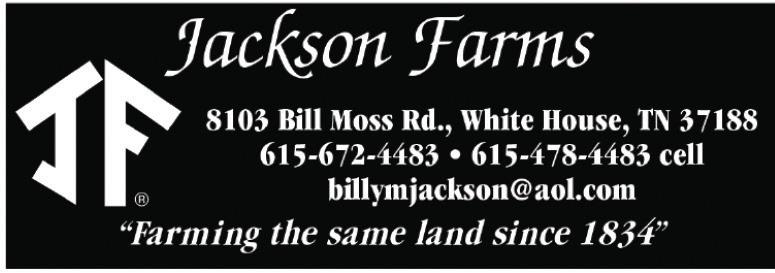




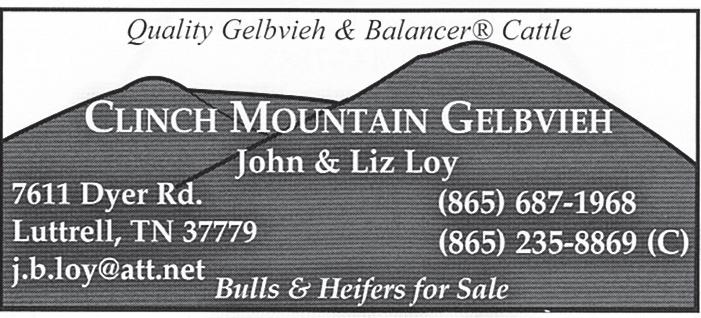

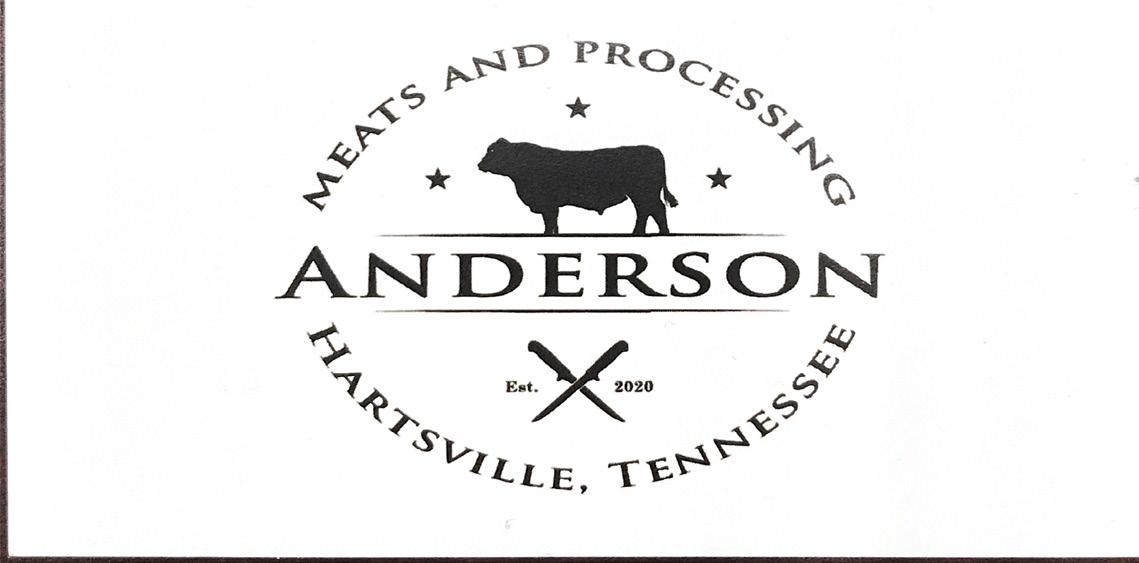
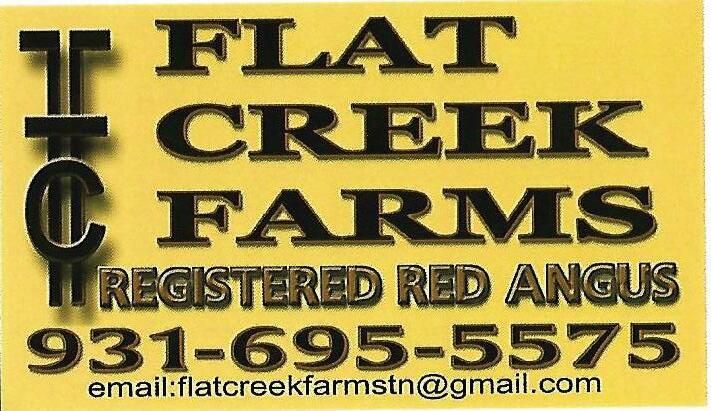
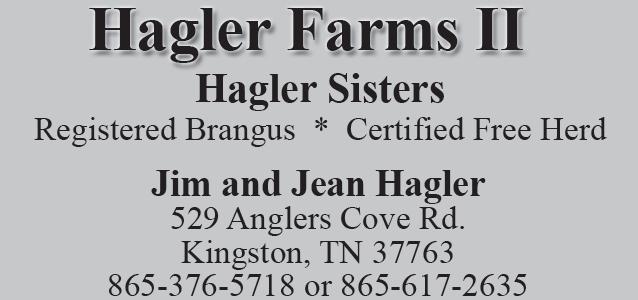
25 for Club Steers, Shorthorn, Shorthorn Plus, and Blue Roan Heifers www.smokymountainfarmandranch.com Registered Polled Herefords Homozygous Black and Homozygous Polled Bulls & Heifers for Sale (615) 374-7990 PO Box 215 Cross Plains, TN 37049 Phone: 615-478-4483 PO Box 215 Cross Plains, TN 37049 Phone: 615-478-4483 billymjackson@aol.com Farms & Businesses to consider for your needs 865-617-2635 Kathryn Ingram 423-337-1383

26
Amonett Anderson Angus Clemson U
Clinch Mtn Creek Insurance Farmington Five Oaks Flat Creek Gilreath Hagler II Hunt’s Jackson JM Cattle Kubota Chatt Ligon Mid South Ag Mid Tn Hereford MLS Mountain Breeze Nufarm Ragland Riverbend
21 25 12 4 25 9 7 25 25 25 25 10 25 9 11 23 9 25 7 16 6 8 25
Smoky Mtn
TBIC TN Farmers Wagyu White Hawk Woodard Yon
2023 CALENDAR
JANUARY
JAN. 2-3: TCA Convention & Trade Show - Lebanon, TN
JAN. 12: UT’s Bull Development & Evaluation Program Sale - Spring Hill, TN
FEBRUARY
FEB. 1-3: Cattle Industry Convention and NCBA Trade Show - New Orleans, LA
FEB. 4: Clemson Extension Bull Test Sale - Garrison Livestock Arena, Pendleton, SC
FEB. 4: JM Cattle Co. Bull Sale - Lawrenceburg, TN
FEB. 17: White Hawk Ranch Beefmaker Bull Sale - Buchanan, GA
FEB. 18: Yon Family Farms Spring Sale - Ridge Spring, SC
FEB. 18: MTSU B&B Preview Show - Murfreesboro, TN
FEB. 24: Tennessee Grazing Conference - Ward Ag Center, Lebanon, TN

FEB. 25: Hunt’s H+ Brangus Bull + Female Sale - Calhoun, GA

FEB. 27: Robert Elliott & Sons Production Sale - Adams, TN
MARCH
MARCH 7: Ag Day on the Hill - Nashville, TN
MARCH 11-12: Tennessee Agribition Show and Sales - Lebanon, TN
MARCH 18: West TN Spring Classic Cattle Show - Trenton, TN
MARCH 18: Red Hill Farms More Than A Bull Sale XVIII - Lafayette, TN
APRIL
APRIL 14: Farmington Angus + Friends Inaugural Anniversary Sale - Normandy, TN
APRIL 29: Cumberland Mountain Showdown - Pikeville, TN MAY
MAY 29: White Hawk Ranch Beefmaker Female Sale - Buchanan, GA
JUNE
JUNE 17: UTIA Smoking School - Knoxville, TN
ADVERTISING INDEX
JUNE 29-JULY 1: Tennessee Junior Beef Expo - Lebanon, TN 27
25 17 28 15 21 8 13


































 BY MELINDA PERKINS TCA’s Director of Youth Programs & Outreach
BY MELINDA PERKINS TCA’s Director of Youth Programs & Outreach














































































